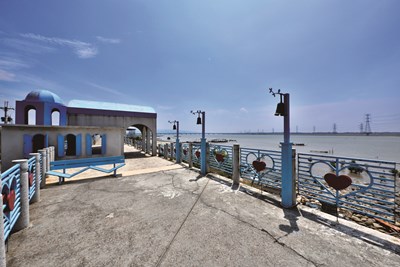
Seeking Taichung's lost ports From Shuiligang to Wuqigang and Tugekugang
Sponsored by Hao Hsi
Words by Cai Jin-ding
Translated by Anna Yang
Photography by Reflection Photography
In the 1750's, in order to prevent pirates, Shuiligang ("gang" meaning "harbor" in Chinese) was built in what today is southwestern Taichung city. Thanks to rice exports to China from central Taiwan, several Taichung harbors, including Wuqigang in the north and Tugekugang in the south between Dajia and Dadu rivers, flourished as shipping stimulated coastal economies in Taiwan and China's Shangtou, Xiamen and Fuzhou.
Despite their critical roles in the past, the above central Taiwan shipping hubs are today largely unfamiliar to residents, making this a good opportunity to step back in time and take a nostalgic journey of exploration to Taichung's forgotten ports.
Military port in Shuili
Besides boosting economic growth, the main purpose for building seaports in central Taiwan was military defense. Due to the unique geography of Shuiligang in Longjing, the earliest military base was built there. In the 18th century, it served as a port where small boats docked, and by the end of the 18th century it was the main training base for military reserve forces from Lugang and other towns in Changhua. Shuiligang was then replaced in this role by Wuchagang in the 1850s.
In 1836, "Changhuaxianzhi" (Changhua's local almanac) noted, "Ten kilometers north of Shuiligang is Wuchagang, which has several boats docked there. Shuiligang is recommended for settling in." In the end, Shuiligang's undoing was silt and mud that made it difficult for boats to dock and led them to divert to other harbors, to the economic benefit of Wuqigang and Tugejuigang.
Shuiligang township still exists today, but what about its harbor? If you open up a Taichung city map, you will actually find this place. What was once Shuiligang by Dadu River is today Lishui harbor in Lishui township, Longjing district. Its scenic Greek-style viewing platform on top of a river embankment is a famous tourist spot, popular with couples and groups who come here to bike and enjoy beautiful sunsets and evening scenes under starry skies. Nowadays, it's certainly hard to imagine that this fascinating place also has a significant historic legacy related to famed central Taiwan pirate Tsai Qian.
Well-known commercial port named after 'Wucha' sand bar
The decline of Shuiligang led to a flourishing Wuqigang, once known as "Wuchagang" with its lagoon and convergence of five windy waterways extending from Niuma Creek. In 1770, commercial junks began sailing between Wuqigang and Fujian province ports. Although central Taiwan's ports and economy saw growth from about 1820, this golden era did not last long. Once again, due to the accumulating mud and silt, boats needed to search for alternate ports, leading to decreases in shipping business.
Trading did thrive between Wuqigang and China's Fujian province during the Japanese colonial era, with exported rice to China being the main form of cross-Strait trade. In 1938, Taiwan's colonial Office of the Governor put forth a "Wuqi Port Construction Plan" and named this project site "Shingaogang"' during the groundbreaking ceremony. However, this project was later brought to a halt in 1944 by World War II. Decades later, the plan was resurrected and Taichung Port was completed between 1971 and 1976 as part of the ROC government's acclaimed 10 national construction projects.
Today, some people may wonder why Wuqi port isn't in fact in Wuqi district but, rather, in Qingshui. In fact, the vanished seaport was doomed, due to extensive modern seaport construction. Wuqi residents for a long time relied on the sea for their livelihoods, leading it be also known as a "yuliao"' (fishermen's village). Although the commercial port there disappeared, many locals continued to support themselves by fishing or collecting shells after World War II ended. However, construction of Taichung Port meant that a good number of fishermen were forced to leave their seaside hometown. Later in 2000, the government bought 87 fishing boats for NT$7 million putting an end to fishing in Wuqi district.
Modern-day Taichung Port Wuqi Tourist Fish Market in Qingshui district is a famous weekend destination although the the original scenes of Wuqi's old flourishing streets have long disappeared with only a few elegant-looking houses on Wuqi Old Street hinting at the past.
Wuqi Old Street at night
Starting in the flourishing 1850's, temples were built in growing numbers along Wuqi's streets, with every temple representing the settlement of more newcomers in the seaport. Among these, the most special are Chaoyuan Temple and the historic Jenwu Temple.
The goddess Meichou's Chaoyuan Temple, built in 1857, reveals the economic stability of the past, with a variety of wall plaques explaining the temple’s extraordinary story. The fine, classic stone-carved dragons on its pillars spiral all the way to the ceiling. The most eye-catching stone sculpture with calligraphy was created by Chinese calligraphy master Huang Hai-quan, helping to make this temple a beautifully-decorated artistic and cultural shrine.
Opposite Chaoyuan Temple, the historic Jenwu Temple was built in 1846 to worship the god Hsuen Tien, who watches over fishermen at sea. Today, it retains all of its original and traditional characteristics, which led to it becoming a main filming spot for the movie "Din-Tao: Leader of the Parade". The temple possesses a Qing dynasty plaque known as "Wei-Chao-Ying-Yu", which refers to the historic background of the Wuqi residents who protected their homeland with sacrifices. Visiting this old temple at night with the moon hanging overhead is a great way to enjoy the beauty of this Minnan-style religious structure.
Delicious flavors on an old street
If you head north of Chaoyuan Temple, you will encounter the old Wuqi police station and dormitory, a majestic and historic symbol of the Japanese colonial period. On Wuqi Old Street, the granolithic concrete walls are the highlight, emblazoned with owners' names and trading logos such as Hongfutai, Feitongan, Linjian, Xintongcheng, and Yingchuansienpie, all representing past stories of success.
The old street has also maintained its traditional culinary flavors with several establishments around the port famed for seafood. Hailong Seafood is a local favorite while the popular New Palace Restaurant across the street being part of a famous dining chain founded in Wuqi. Besides seafood, a traditional cooling soybean pudding shop by the banyan tree and Linyixianjai salty cakes are the top souvenir choices for visitors. If you are an early bird, an old breakfast place famed for clay-oven rolls and fried bread sticks is right across from Wangxin Wangye Temple.
Recently, this street has also seen a generational "boomerang effect" take place, after a group of young people settled in and launched "Wuqifeng Magazine" about a year ago, circulating Wuqi news and stories all around the country. Wuhejia Intestine Vermicelli shop, in the arcade of the old Linjian shop, is run by another young owner Mr. Chen, who decided to return to his hometown to promote delicious half-century-old flavors. Although these businesses are still in their infancy, they represent dream careers for their youthful founders.
Now submerged: The original Tugekugang
Around the 20th century, Tugekugang was another important harbor alongside Shuiligang and Wuqigang. In 1887, mud in Wuqigang made docking difficult for vessels, which were redirected to Tugejuegang about 7.5 kilometers south of Wuqi. Previously, this port handled ships over 50 tons in displacement with smaller boats being allowed into Wuqigang. By the end of Qing dynasty, both Wuqi and Tugejue harbors served as the main shipping depots for central Taiwan, with the main export products being rice and camphor, mostly grown locally. Thus, Attabu rice and Dongshijao camphor were shipped to the mainland from here.
Being able to handle larger ships and loads than Daan and Wuqi made Tugeku's harbor central Taiwan's second most-important port after Lugang for a period. This status and high point for the harbor lasted until the beginning of the Japanese colonial era. In July, 1911, however, heavy rainfall overflowed the Dadu River and inundated Tugeku's main town. The flood caused the relocation of nearby Fuchou village to the north bank of Dadu River; several collapsed houses were buried under rice paddies in what is today Changhua's Shengang township. The relocated village was renamed Lishue, relegating the name of Tugeku to largely-forgotten history.
Any interested explorer or excavator of this historic underwater site would probably discover a variety of artifacts and other objects representative of Taiwan's earlier generation of immigrants, educating modern-day Taichung residents on their ancestors from the last century. Today, when you visit Lishui harbor for the sunset view on its scenic platform, don't forget to take a moment to consider Taichung's underwater "Atlantis" and imagine life in the once well-known Tugeku fishermen's village.
------------------------------------------------------------------------------
Tour guide:
Tsai Chin-ding
Mr. Tsai is a well-known Taichung cultural expert and historian. His parents worked as fish vendors in a traditional market, where a pork vendor served as his childhood napping place. His academic research includes cultural economics and social studies, and he has a special interest in socially-marginalized groups of people. Among his special interests are professional mourners, Chinese veterans, traditional markets, betel nut businesses, and other religious events.

 Facebook
Facebook
 Twitter
Twitter
 LINE
LINE